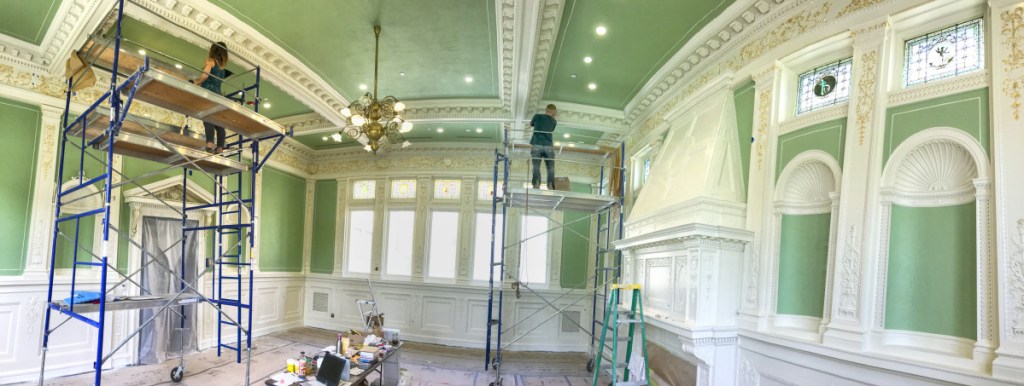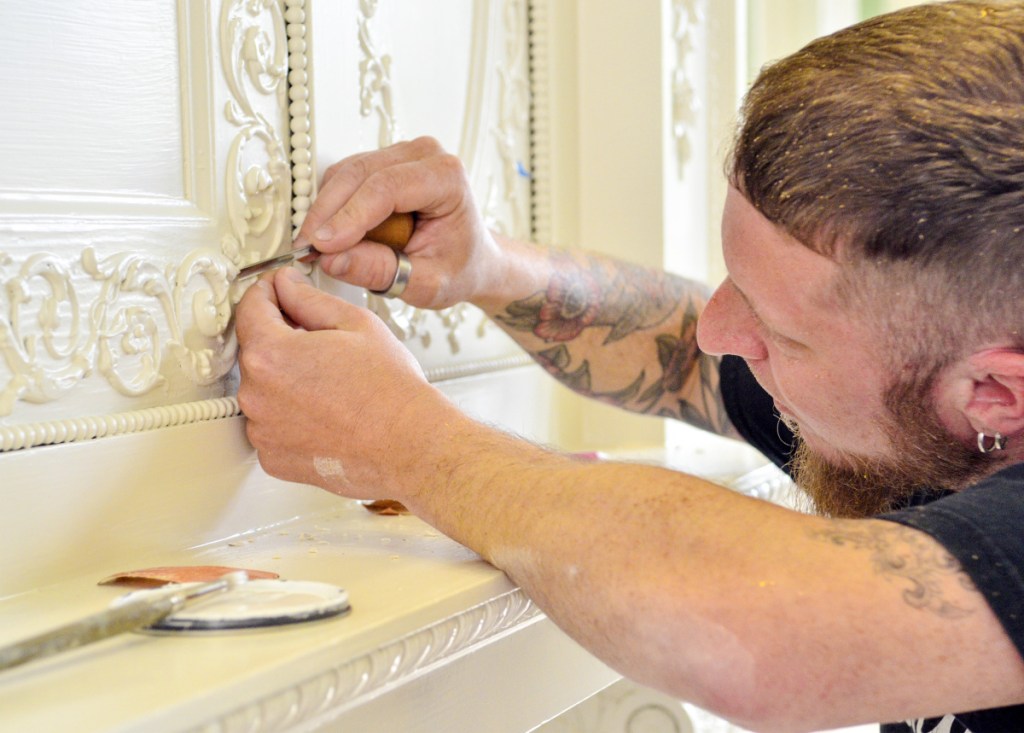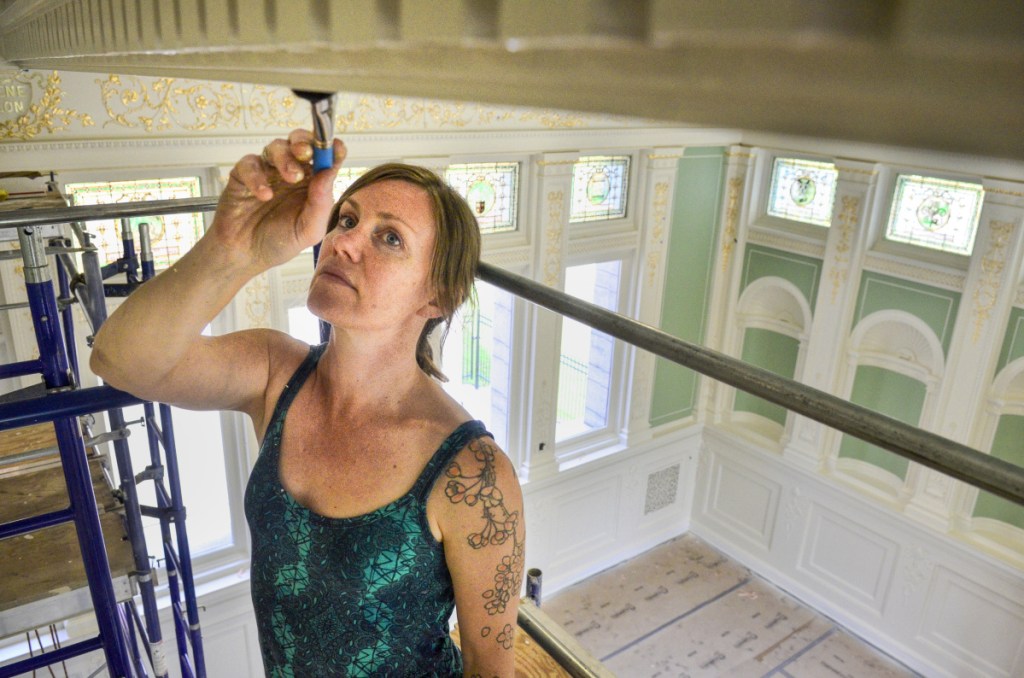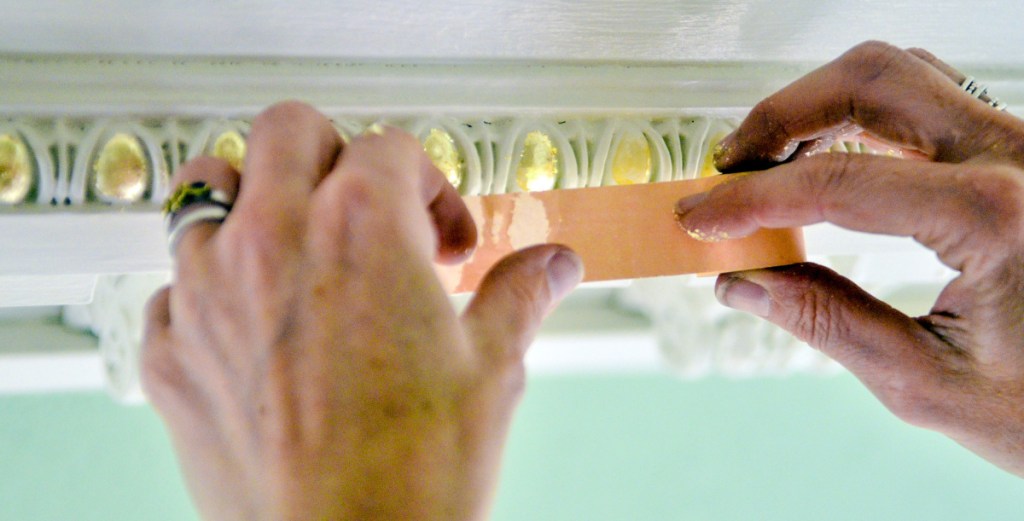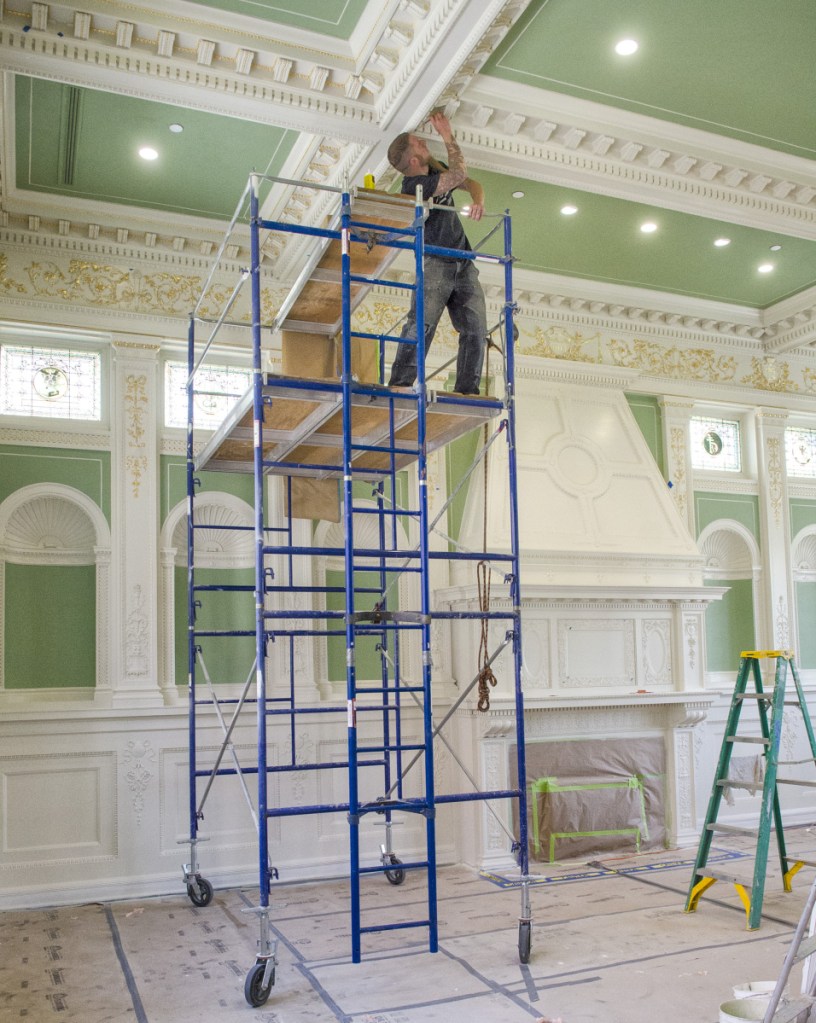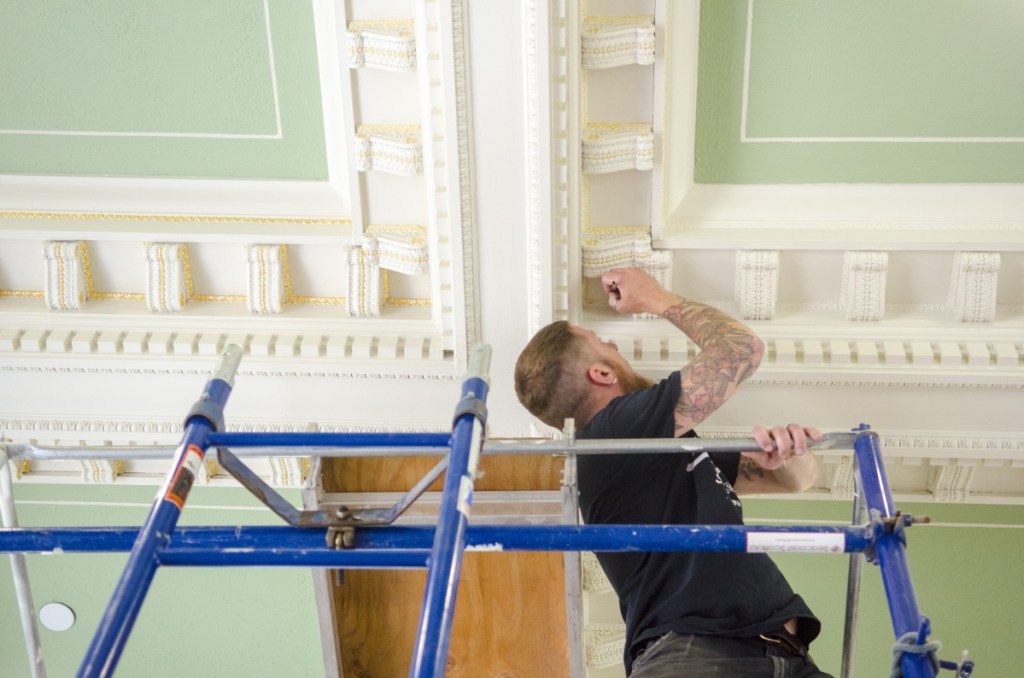AUGUSTA — Lithgow Public Library’s reading room had a secret, but not the kind found in mystery books or even a diary.
It’s hiding underneath multiple layers of paint and broken plaster from previous restoration efforts done over the last 122 years.
The secret that the ornate room held, until recently, was its original paint colors — which, it turns out, weren’t quite what even longtime library workers thought they were.
Tony Castro and his highly detail-oriented painters, following on the heels of ornamental plaster specialist Jon Sampson, are working to bring that secret to the surface and put it on display in all its green, ivory and gold-leaf glory.
The project should make the already spectacular reading room, which features intricately detailed stained glass windows and an array of elaborate, gold-leaf-topped plaster trim details, even more so.
“When people see it, it takes their breath away,” library Executive Director Elizabeth Pohl said of the spectacular, stately room. “It really is bringing the beauty back to this room.”
It follows about seven weeks of painstaking paint restoration work, with about a month more of work to go before it’s complete.
The $82,000 project is being paid for by private funds, raised by the Friends of Lithgow Library, a group that also raised roughly $2.7 million to help expand and renovate the library in an $11 million project largely completed in 2016.
Pohl said the work wasn’t included in the major expansion and renovation project out of concern it would be too costly, so it was pulled out of that larger project.
Wick Johnson, co-chairman of the Lithgow fundraising campaign, told city councilors last month the detailed level of work required in the reading room is expensive but needed to complete the restoration of the library to its past splendor.
“The reading room is obviously a spectacular space, and the friends felt very strongly it needs to be restored to its original grandeur,” Johnson said. “It’s fairly expensive, but it is preparing this building for another 100 years, if you think about it.”
The main walls of the reading room were painted as part of the larger library restoration project, in a shade of blue-ish green library officials had found underneath newer paint, which led them to believe it was the original paint color.
Castro suggested they have Amy Cole Ives, president of Augsuta-based Sutherland Conservation and Consulting, analyze the paint in the room to determine its original color. Ives used Sutherland’s paint analysis laboratory to do a cross-section microscopy of the paint, and she found the original paint colors.
The green turned out to be a different, brighter shade than what was used in the recent repainting job. They discovered the trim paint, too, was a different color, an ivory instead of the previous darker trim.
Castro said without that technology, he would have done his best, with a scalpel and a magnifier, to determine the original paint color and match it. He said they found some covered-up plaster with the original green on it, but it had yellowed, so matching what it looked like new would have been a challenge without Ives’ work.
Castro, owner of New Gloucester-based Tony Castro and Co., said the difference in the level of work that goes into such a project, versus, say, someone painting a living room a new shade of white, is the amount of preparation involved.
“A painter doing your living room is probably thinking, ‘If it holds up for 10 years, I’m good,'” Castro said. “Something like this, you’re thinking 50, or 100 years. You want it to be a long-term thing. So the preparation is at a very high level.”
Other significant Maine paint restoration projects Castro has worked on include Joshua Chamberlain’s former house in Brunswick, Cumston Hall in Monmouth, and the Bowdoin Chapel. Castro said he feels blessed to be able to work on such properties.
Before Castro and two other painters got started, ornamental plaster expert Jon Sampson, of Portland-based Sampson and Co., restored the finely detailed — and somewhat banged-up — plaster trim pieces that line the library room, which has been closed to the public while the work takes place. He made molds to replace all the major broken pieces of plaster.
Pohl said both Sampson and Castro came highly recommended by historical architecture experts.
“I brought in some other plaster repair companies and they came in, took one look at this, and said, ‘You may want to call Jon Sampson,'” Pohl said. “He’s the only one who didn’t seem afraid to take on this kind of work.”
Castro and two painters, his daughter Alpha Castro and Chris Blackburn, have spent about seven weeks on the job, and he thinks it’ll take three or four more weeks to finish.
Included in the work is placing two shades of gold leaf, imported from Italy, on the numerous detailed plaster moldings that decorate nearly every section of wall.
Castro said the reading room has the most gold-leaf of any project he’s worked on before.
The original gold leaf had been marred with paint from previous repainting efforts.
One area of the room, the trim surrounding the elaborate entryway, will remain with the original gold-leaf trim, to retain at least some of that original work.
White pin-striping on some sections of wall, which Pohl said library officials didn’t realize was part of the original paint scheme, also was returned to the walls.
She said the pinstripe was spotted in an old photograph of the reading room.
The green base wall paint and ivory trim paint, made to match the original colors, are Benjamin Moore paints; so, Castro said, the paints should be matched easily if they need to get more of it for touch-up work. He said he’d leave the library with a gallon of each.
Castro said the project was unusual for him because usually his goal is to preserve as much of what is in place as possible, adding new paint to the preserved material. This project, however, involved removing work done in intervening years to bring the room back to its original appearance, using many new pieces of molded plaster.
Pohl said library leaders discussed whether to do such a comprehensive restoration of the reading room’s plaster and paint and decided the library restoration didn’t feel complete without it.
“The Friends decided this is what they wanted to do, and we’re glad they did,” Pohl said. “What a great gift to the community. It certainly needed repair. A lot of plaster ornamentation was broken or missing. It looked a little beaten-up even after it was painted. It seemed like, to really complete the restoration, this needed to be done.”
Keith Edwards — 621-5647
Send questions/comments to the editors.


